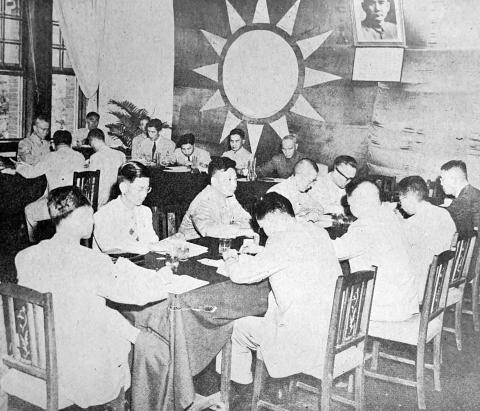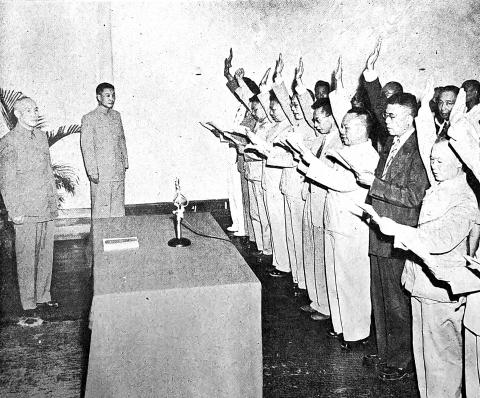Jan. 20 to Jan. 26
Party members calling for the Chinese Nationalist Party (KMT) to reform after last week’s elections have been using the word gaizao (改造) — the exact same phrase the party used 70 years ago for its two-year restructuring plan.
Although using the same word, the nature and circumstances of the two events are vastly different. In 1950, the KMT had just retreated to Taiwan after losing the Chinese Civil War, and its leader Chiang Kai-shek (蔣介石) has just resumed his presidency on March 1.

Photo courtesy of National Central Library
Chen Sheau-huey (陳曉慧) writes in “Revolution from the top down: a study on the reform of Kuomintang” (由上而下的革命:中國國民黨改造之研究), “After losing China, could the KMT discard its old baggage, shed its weak and corrupt image and create a new opportunity to oppose the communists and reclaim their country?” The KMT even considered changing its name to signal a new beginning at one point, but ultimately decided not to.
Chen writes that historians generally offer two different takes on the results. One side states that the restructuring process gave the KMT new life to secure its footing in Taiwan, and using the island as a centralized base, the party was able to build Taiwan’s economy and launch it to prosperity. Critics, however, say that it merely led to a redistribution of power within the KMT that allowed Chiang to rule Taiwan as a strongman.
Nevertheless, “by the end of the process in October 1952, the reformed KMT essentially had complete control over the Republic of China government as well as Taiwan,” Chen writes.

Photo courtesy of National Central Library
NEED FOR CHANGE
Chiang originally drafted the party restructuring plan in July 1949 to better deal with the ongoing Chinese Civil War, but after the KMT’s expulsion from China, he had to reconsider the entire operation. A new plan was devised in January 1950.
By then, the Korean War was underway and the US had changed its policy on not helping Taiwan, sending the Taiwan Patrol Force to keep both sides from attacking each other. Chiang took this lull in action to launch the plan.
Chiang notes in the plan’s introduction that this would be the KMT’s sixth such restructuring, the first taking place in 1914 when founder Sun Yat-sen (孫逸仙) established the Chinese Revolutionary Party in exile after the demise of the Nationalist Party.
“In the past 40 years, every time our country’s survival and the success of our national revolution was at stake, we dedicated ourselves to party reform,” he writes.
Aside from internal instability caused by government misrule after World War II and the massive influx of refugees from China, the party was also plagued by infighting that intensified after World War II. Chen lists four major factions within the party when the reform began, most notably the CC Clique led by brothers Chen Kuo-fu (陳果夫) and Chen Li-fu (陳立夫), whose uncle was an early mentor of Chiang. The KMT believed that internal discord, in addition to disconnect with the general populace, was the main reason they lost the Chinese Civil War.
On Aug. 5, 1950, the 16-person restructuring committee began its work. Chen writes that the committee was made up of relatively young and well-educated party members with close ties to Chiang, including then-premier Chen Cheng (陳誠) and Chiang’s son, Chiang Ching-kuo (蔣經國).
In September, the KMT announced its updated political objectives: “To reform the organization of the party, to establish discipline within the party, to change the party’s operational methods, and transform the party into a powerful fighting body that carried out the Three Principles of the People,” as well as “stabilizing and developing Taiwan.”
TOTAL CONTROL
First was the reorganizing of party members. KMT members who came from China needed to re-register, undergo re-education and swear loyalty to Chiang, and were then organized into about 30,000 small groups that averaged six members each.
These small groups were required to hold meetings twice a week, study party ideals and work closely with the people. Starting in 1951, they were assigned different segments of society — peasants, workers, youth, Aboriginals, urban dwellers, and so on, and carried on their tasks among the ordinary populace while spreading the party’s influence.
The KMT also started actively recruiting. In 1950, it gained almost 28,000 new members, 36.7 percent of them under 25 years old and 60 percent Taiwanese. Many underwent “training” through touring programs organized by the Institute of Revolutionary Practice (革命實踐研究院), with the main purpose to strengthen their loyalty to the party and Chiang.
Meanwhile, Chiang looked to stop the rampant factionalism. Shut out of the restructuring process and at odds with Chen Cheng, Chen Li-fu moved his family to the US (reportedly under Chiang’s suggestion), remaining there for 18 years. Chen Kuo-fu was already ill and died in 1951. Chiang managed to subdue most of the other cliques this way by removing their leaders from power and having the members swear loyalty to him. This endeavor was not entirely successful, but at least nobody openly opposed Chiang anymore.
The restructuring and training programs to bolster KMT loyalty also took place in the military and secret intelligence service. The party also organized groups for students, laborers, farmers and women to further its reach. During this time, the KMT also exerted influence over the cultural sphere through censorship and programs that promoted patriotic and anti-communist literature.
Taiwan was already under martial law by then, and coupled with the Temporary Provisions Effective During the Period of National Mobilization for Suppression of the Communist Rebellion (動員戡亂時期臨時條款), Chiang effectively secured his position as the undisputed leader of a one party-state that tightly controlled the government, military and society.
Taiwan in Time, a column about Taiwan’s history that is published every Sunday, spotlights important or interesting events around the nation that have anniversaries this week.

On April 26, The Lancet published a letter from two doctors at Taichung-based China Medical University Hospital (CMUH) warning that “Taiwan’s Health Care System is on the Brink of Collapse.” The authors said that “Years of policy inaction and mismanagement of resources have led to the National Health Insurance system operating under unsustainable conditions.” The pushback was immediate. Errors in the paper were quickly identified and publicized, to discredit the authors (the hospital apologized). CNA reported that CMUH said the letter described Taiwan in 2021 as having 62 nurses per 10,000 people, when the correct number was 78 nurses per 10,000

As we live longer, our risk of cognitive impairment is increasing. How can we delay the onset of symptoms? Do we have to give up every indulgence or can small changes make a difference? We asked neurologists for tips on how to keep our brains healthy for life. TAKE CARE OF YOUR HEALTH “All of the sensible things that apply to bodily health apply to brain health,” says Suzanne O’Sullivan, a consultant in neurology at the National Hospital for Neurology and Neurosurgery in London, and the author of The Age of Diagnosis. “When you’re 20, you can get away with absolute

May 5 to May 11 What started out as friction between Taiwanese students at Taichung First High School and a Japanese head cook escalated dramatically over the first two weeks of May 1927. It began on April 30 when the cook’s wife knew that lotus starch used in that night’s dinner had rat feces in it, but failed to inform staff until the meal was already prepared. The students believed that her silence was intentional, and filed a complaint. The school’s Japanese administrators sided with the cook’s family, dismissing the students as troublemakers and clamping down on their freedoms — with

As Donald Trump’s executive order in March led to the shuttering of Voice of America (VOA) — the global broadcaster whose roots date back to the fight against Nazi propaganda — he quickly attracted support from figures not used to aligning themselves with any US administration. Trump had ordered the US Agency for Global Media, the federal agency that funds VOA and other groups promoting independent journalism overseas, to be “eliminated to the maximum extent consistent with applicable law.” The decision suddenly halted programming in 49 languages to more than 425 million people. In Moscow, Margarita Simonyan, the hardline editor-in-chief of the